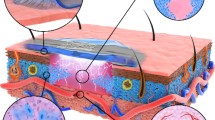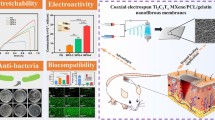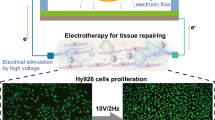Abstract
Electrical stimulation therapy has attracted widespread attention for its advantages of promoting cell proliferation and tissue regeneration, accelerating skin barrier restoration, and reducing scars. Its effect on accelerating wound healing has been clinically proven. However, traditional electrical stimulation therapy requires large power supply devices, which are inconvenient to carry and use. Therefore, self-powered flexible nano-piezoelectric membranes were developed in this work, which can generate electric field under mechanical stimulation to effectively eliminate bacteria and accelerate wound healing. In this work, poly(vinylidene fluoride-trifluoroethylene) (P(VDF-TrFE)) piezoelectric membranes were fabricated by electrospinning, and better piezoelectric properties were obtained by adding tetrabutylammonium chloride (TBAC), and their antibacterial and pro-healing effects were investigated with or without mechanical stimulation. Results showed that the output voltage of P(VDF-TrFE)/TBAC piezoelectric membrane was about 5.3 times higher than that of P(VDF-TrFE). Furthermore, the P(VDF-TrFE)/TBAC piezoelectric membrane had excellent antibacterial effect against both Escherichia coli and Staphylococcus aureus after mechanical stimulation, and the inhibition rates of Staphylococcus aureus and Escherichia coli were 71.43% and 97.25%, respectively. Meanwhile, the results of in vivo and in vitro healing promotion experiments showed that P(VDF-TrFE)/TBAC piezoelectric membrane was effective in promoting cell growth and wound healing after mechanical stimulation, the wound was almost completely healed on the 7th day, and the healing rate was increased by about 37% compared with the blank. The P(VDF-TrFE)/TBAC flexible piezoelectric membrane is effective in electrical stimulation for wound healing, and it has potential applications in wound treatment.
Graphical abstract












Similar content being viewed by others
References
Niranjan R, Kaushik M, Selvi RT, Prakash J, Venkataprasanna KS, Prema D, Pannerselvam B, Venkatasubbu GD (2019) PVA/SA/TiO2-CUR patch for enhanced wound healing application: in vitro and in vivo analysis. Int J Biol Macromol 138:704–717. https://doi.org/10.1016/j.ijbiomac.2019.07.125
Yu C, Hu Z-Q, Peng R-Y (2014) Effects and mechanisms of a microcurrent dressing on skin wound healing: a review. Mil Med Res 1:24–24. https://doi.org/10.1186/2054-9369-1-24
Khamaisi M, Balanson S (2017) Dysregulation of wound healing mechanisms in diabetes and the importance of negative pressure wound therapy (NPWT). Diabetes-Metab Res Rev 33:e2929. https://doi.org/10.1002/dmrr.2929
Kasprzyk-Kucewicz T, Cholewka A, Englisz-Jurgielewicz B, Mucha R, Relich M, Kawecki M, Sieron K, Onak P, Stanek A (2021) Thermal effects of topical hyperbaric oxygen therapy in hard-to-heal wounds—a pilot study. Int J Environ Res Public Health 18:6737. https://doi.org/10.3390/ijerph18136737
Langer MD, Lewis GK (2014) Sustained acoustic medicine for stimulation of wound healing: a translational research report. J Acoust Soc Am 136:2091–2094. https://doi.org/10.1121/1.4899528
Maan ZN, Januszyk M, Rennert RC, Duscher D, Rodrigues M, Fujiwara T, Ho N, Whitmore A, Hu MS, Longaker MT, Gurtner GC (2014) Noncontact, low-frequency ultrasound therapy enhances neovascularization and wound healing in diabetic mice. Plast Reconstr Surg 134:402E-411E. https://doi.org/10.1097/prs.0000000000000467
Lyu W, Ma Y, Chen S, Li H, Wang P, Chen Y, Feng X (2021) Flexible ultrasonic patch for accelerating chronic wound healing. Adv Healthc Mater 10:2100785. https://doi.org/10.1002/adhm.202100785
Abedin-Do A, Zhang Z, Douville Y, Methot M, Bernatchez J, Rouabhia M (2022) Electrical stimulation promotes the wound-healing properties of diabetic human skin fibroblasts. J Tissue Eng Regen Med 16:643–652. https://doi.org/10.1002/term.3305
Kai H, Yamauchi T, Ogawa Y, Tsubota A, Magome T, Miyake T, Yamasaki K, Nishizawa M (2017) Accelerated wound healing on skin by electrical stimulation with a bioelectric plaster. Adv Healthc Mater 6:1700465. https://doi.org/10.1002/adhm.201700465
Milne J, Swift A, Smith J, Martin R (2021) Electrical stimulation for pain reduction in hard-to-heal wound healing. J Wound Care 30:568–580. https://doi.org/10.12968/jowc.2021.30.7.568
Polak A, Franek A, Taradaj J (2014) High-voltage pulsed current electrical stimulation in wound treatment. Adv Wound Care 3:104–117
Franek A, Kostur R, Polak A, Taradaj J, Szlachta Z, Blaszczak E, Dolibog P, Dolibog P, Koczy B, Kucio C (2012) Using high-voltage electrical stimulation in the treatment of recalcitrant pressure ulcers: results of a randomized, controlled clinical study. Ostomy Wound Manag 58:30–44
Cunha F, Rajnicek AM, McCaig CD (2019) Electrical stimulation directs migration, enhances and orients cell division and upregulates the chemokine receptors CXCR4 and CXCR2 in endothelial cells. J Vasc Res 56:39–53. https://doi.org/10.1159/000495311
Tai G, Tai M, Zhao M (2018) Electrically stimulated cell migration and its contribution to wound healing. Burns Trauma. https://doi.org/10.1186/s41038-018-0123-2
Yu C, Xu Z-X, Hao Y-H, Gao Y-B, Yao B-W, Zhang J, Wang B, Hu Z-Q, Peng R-Y (2019) A novel microcurrent dressing for wound healing in a rat skin defect model. Mil Med Res 6:22. https://doi.org/10.1186/s40779-019-0213-x
Shi X, Chen Y, Zhao Y, Ye M, Zhang S, Gong S (2022) Ultrasound-activable piezoelectric membranes for accelerating wound healing. Biomater Science 10:692–701. https://doi.org/10.1039/d1bm01062j
Du S, Zhou N, Gao Y, Xie G, Du H, Jiang H, Zhang L, Tao J, Zhu J (2020) Bioinspired hybrid patches with self-adhesive hydrogel and piezoelectric nanogenerator for promoting skin wound healing. Nano Res 13:2525–2533. https://doi.org/10.1007/s12274-020-2891-9
Bhang SH, Jang WS, Han J, Yoon J-K, La W-G, Lee E, Kim YS, Shin J-Y, Lee T-J, Baik HK, Kim B-S (2017) Zinc oxide nanorod-based piezoelectric dermal patch for wound healing. Adv Funct Mater 27:1603497. https://doi.org/10.1002/adfm.201603497
Murillo G, Blanquer A, Vargas-Estevez C, Barrios L, Ibáñez E, Nogués C, Esteve J (2017) Electromechanical nanogenerator-cell interaction modulates cell activity. Adv Mater 29:1605048. https://doi.org/10.1002/adma.201605048
Augustine R, Dan P, Sosnik A, Kalarikkal N, Tran N, Vincent B, Thomas S, Menu P, Rouxel D (2017) Electrospun poly(vinylidene fluoride-trifluoroethylene)/zinc oxide nanocomposite tissue engineering scaffolds with enhanced cell adhesion and blood vessel formation. Nano Res 10:3358–3376. https://doi.org/10.1007/s12274-017-1549-8
Wu M, Zhang Z, Liu Z, Zhang J, Zhang Y, Ding Y, Huang T, Xiang D, Wang Z, Dai Y, Wan X, Wang S, Qian H, Sun Q, Li L (2021) Piezoelectric nanocomposites for sonodynamic bacterial elimination and wound healing. Nano Today. https://doi.org/10.1016/j.nantod.2021.101104
Liu L, Chen B, Liu K, Gao J, Ye Y, Wang Z, Qin N, Wilson DA, Tu Y, Peng F (2020) Wireless manipulation of magnetic/piezoelectric micromotors for precise neural stem-like cell stimulation. Adv Funct Mater 30:1910108. https://doi.org/10.1002/adfm.201910108
Hoop M, Chen X-Z, Ferrari A, Mushtaq F, Ghazaryan G, Tervoort T, Poulikakos D, Nelson B, Pané S (2017) Ultrasound-mediated piezoelectric differentiation of neuron-like PC12 cells on PVDF membranes. Sci Rep 7:1–8. https://doi.org/10.1038/s41598-017-03992-3
Zhang X, Cui X, Wang D, Wang S, Liu Z, Zhao G, Zhang Y, Li Z, Wang ZL, Li L (2019) Piezoelectric nanotopography induced neuron-like differentiation of stem cells. Adv Func Mater 29:1900372. https://doi.org/10.1002/adfm.201900372
Guo H-F, Li Z-S, Dong S-W, Chen W-J, Deng L, Wang Y-F, Ying D-J (2012) Piezoelectric PU/PVDF electrospun scaffolds for wound healing applications. Colloids Surf, B 96:29–36. https://doi.org/10.1016/j.colsurfb.2012.03.014
Cheng Y, Xu Y, Qian Y, Chen X, Ouyang Y, Yuan W-E (2020) 3D structured self-powered PVDF/PCL scaffolds for peripheral nerve regeneration. Nano Energy 69:104411. https://doi.org/10.1016/j.nanoen.2019.104411
Wang AC, Hu M, Zhou LW, Qiang XY (2019) Self-powered well-aligned P(VDF-TrFE) piezoelectric nanofiber nanogenerator for modulating an exact electrical stimulation and enhancing the proliferation of preosteoblasts. Nanomaterials 9:349. https://doi.org/10.3390/nano9030349
Wang A, Liu Z, Hu M, Wang C, Zhang X, Shi B, Fan Y, Cui Y, Li Z, Ren K (2018) Piezoelectric nanofibrous scaffolds as in vivo energy harvesters for modifying fibroblast alignment and proliferation in wound healing. Nano Energy 43:63–71. https://doi.org/10.1016/j.nanoen.2017.11.023
Scalize PH, Bombonato-Prado KF, de Sousa LG, Rosa AL, Beloti MM, Semprini M, Gimenes R, de Almeida ALG, de Oliveira FS, Hallak Regalo SC, Siessere S (2016) Poly(Vinylidene Fluoride-Trifluorethylene)/barium titanate membrane promotes de novo bone formation and may modulate gene expression in osteoporotic rat model. J Mater Sci Mater Med 27:180. https://doi.org/10.1007/s10856-016-5799-x
Zhang X, Zhang C, Lin Y, Hu P, Shen Y, Wang K, Meng S, Chai Y, Dai X, Liu X, Liu Y, Mo X, Cao C, Li S, Deng X, Chen L (2016) Nanocomposite membranes enhance bone regeneration through restoring physiological electric microenvironment. ACS Nano 10:7279–7286. https://doi.org/10.1021/acsnano.6b02247
Hu X, Ding Z, Fei L, Xiang Y, Lin Y (2019) Wearable piezoelectric nanogenerators based on reduced graphene oxide and in situ polarization-enhanced PVDF-TrFE films. J Mater Sci 54:6401–6409. https://doi.org/10.1007/s10853-019-03339-5
Surmenev RA, Orlova T, Chernozem RV, Ivanova AA, Bartasyte A, Mathur S, Surmeneva MA (2019) Hybrid lead-free polymer-based nanocomposites with improved piezoelectric response for biomedical energy-harvesting applications: a review. Nano Energy 62:475–506. https://doi.org/10.1016/j.nanoen.2019.04.090
Prateek VK, Thakur RK (2016) Gupta, recent progress on ferroelectric polymer-based nanocomposites for high energy density capacitors: synthesis, dielectric properties, and future aspects. Chem Rev 116:4260–4317. https://doi.org/10.1021/acs.chemrev.5b00495
Men T, Liu X, Jiang B, Long X, Guo H (2019) Ferroelectric β-crystalline phase formation and property enhancement in polydopamine modified BaTiO3/poly (vinylidene fluoride-trifluoroethylene) nanocomposite films. Thin Solid Films 669:579–587. https://doi.org/10.1016/j.tsf.2018.11.051
Shi K, Chai B, Zou H, Shen P, Sun B, Jiang P, Shi Z, Huang X (2021) Interface induced performance enhancement in flexible BaTiO3/PVDF-TrFE based piezoelectric nanogenerators. Nano Energy 80:105515. https://doi.org/10.1016/j.nanoen.2020.105515
Li Z, Xu Y, Fan L, Kang W, Cheng B (2016) Fabrication of polyvinylidene fluoride tree-like nanofiber via one-step electrospinning. Mater Des 92:95–101. https://doi.org/10.1016/j.matdes.2015.12.037
Yee WA, Kotaki M, Liu Y, Lu X (2007) Morphology, polymorphism behavior and molecular orientation of electrospun poly(vinylidene fluoride) fibers. Polymer 48:512–521. https://doi.org/10.1016/j.polymer.2006.11.036
Karan SK, Mandal D, Khatua BB (2015) Self-powered flexible Fe-doped RGO/PVDF nanocomposite: an excellent material for a piezoelectric energy harvester. Nanoscale 7:10655–10666. https://doi.org/10.1039/c5nr02067k
Shuai C, Guo W, Wu P, Yang W, Hu S, Xia Y, Feng P (2018) A graphene oxide-Ag co-dispersing nanosystem: dual synergistic effects on antibacterial activities and mechanical properties of polymer scaffolds. Chem Eng J 347:322–333. https://doi.org/10.1016/j.cej.2018.04.092
Wu M, Zhang Z, Liu Z, Zhang J, Zhang Y, Ding Y, Huang T, Xiang D, Wang Z, Dai Y, Wan X, Wang S, Qian H, Sun Q, Li L (2021) Piezoelectric nanocomposites for sonodynamic bacterial elimination and wound healing. Nano Today 37:101104. https://doi.org/10.1016/j.nantod.2021.101104
Hernández N, González-González VA, Dzul-Bautista IB, Ornelas-Soto N, Barandiarán JM, Gutierrez J (2018) Electrospun poly(vinylidene fluoride-trifluoroethylene) based flexible magnetoelectric nanofibers. Eur Polymer J 109:336–340. https://doi.org/10.1016/j.eurpolymj.2018.09.045
Dhakras D, Borkar V, Ogale S, Jog J (2012) Enhanced piezoresponse of electrospun PVDF mats with a touch of nickel chloride hexahydrate salt. Nanoscale 4:752–756. https://doi.org/10.1039/C2NR11841F
Habibur RM, Yaqoob U, Muhammad S, Uddin ASMI, Kim HC (2018) The effect of RGO on dielectric and energy harvesting properties of P(VDF-TrFE) matrix by optimizing electroactive β phase without traditional polling process. Mater Chem Phys 215:46–55. https://doi.org/10.1016/j.matchemphys.2018.05.010
Park C-H, Van Duong Q, Moon Y-J, Ha K, Choi ST (2018) Enhanced thermo-electro-mechanical characteristics of purified P(VDF-TrFE) films for ultrasonic transducers. Sens Actuators, A 279:586–592. https://doi.org/10.1016/j.sna.2018.06.060
Oliveira F, Leterrier Y, Månson J-A, Sereda O, Neels A, Dommann A, Damjanovic D (2014) Process influences on the structure, piezoelectric, and gas-barrier properties of PVDF-TrFE copolymer. J Polym Sci Part B: Polym Phys 52:496–506. https://doi.org/10.1002/polb.23443
Meng N, Mao R, Tu W, Zhu X, Wilson RM, Bilotti E, Reece MJ (2016) Processing and characterization of free standing highly oriented ferroelectric polymer films with remarkably low coercive field and high remnant polarization. Polymer 100:69–76. https://doi.org/10.1016/j.polymer.2016.08.017
Alam MM, Sultana A, Sarkar D, Mandal D (2017) Electroactive beta-crystalline phase inclusion and photoluminescence response of a heat-controlled spin-coated PVDF/TiO2 free-standing nanocomposite film for a nanogenerator and an active nanosensor. Nanotechnology. https://doi.org/10.1088/1361-6528/aa7b25
Zhang K, Li Z, Kang W, Deng N, Yan J, Ju J, Liu Y, Cheng B (2018) Preparation and characterization of tree-like cellulose nanofiber membranes via the electrospinning method. Carbohyd Polym 183:62–69. https://doi.org/10.1016/j.carbpol.2017.11.032
Ju J, Shi Z, Fan L, Liang Y, Kang W, Cheng B (2017) Preparation of elastomeric tree-like nanofiber membranes using thermoplastic polyurethane by one-step electrospinning. Mater Lett 205:190–193. https://doi.org/10.1016/j.matlet.2017.06.083
Shuai C, Liu G, Yang Y, Qi F, Peng S, Yang W, He C, Wang G, Qian G (2020) A strawberry-like Ag-decorated barium titanate enhances piezoelectric and antibacterial activities of polymer scaffold. Nano Energy 74:104825. https://doi.org/10.1016/j.nanoen.2020.104825
Shuai C, Xu Y, Feng P, Wang G, Xiong S, Peng S (2019) Antibacterial polymer scaffold based on mesoporous bioactive glass loaded with in situ grown silver. Chem Eng J 374:304–315. https://doi.org/10.1016/j.cej.2019.03.273
Tan G, Wang S, Zhu Y, Zhou L, Yu P, Wang X, He T, Chen J, Mao C, Ning C (2016) Surface-selective preferential production of reactive oxygen species on piezoelectric ceramics for bacterial killing. ACS Appl Mater Interfaces 8:24306–24309. https://doi.org/10.1021/acsami.6b07440
Zhang X, Yang C, Yang K (2020) Contact killing of cu-bearing stainless steel based on charge transfer caused by the microdomain potential difference. ACS Appl Mater Interfaces 12:361–372. https://doi.org/10.1021/acsami.9b19596
Lai S, Wang Y, Wan Y, Ma H, Fang L, Su J (2022) Magnetoelectric Polymer Membrane-Based Electrical Microenvironment with Magnetically Controlled Antibacterial Activity. ACS Appl Mater Interfaces 14:20139–20150. https://doi.org/10.1021/acsami.2c04359
Brown S, Santa Maria Jr JP, Walker S (2013) Wall teichoic acids of gram-positive bacteria. Ann Rev Microbiol 67:313–336. https://doi.org/10.1146/annurev-micro-092412-155620
Mai-Prochnow A, Clauson M, Hong J, Murphy AB (2016) Gram positive and Gram negative bacteria differ in their sensitivity to cold plasma. Sci Rep 6:38610. https://doi.org/10.1038/srep38610
Kaur S, Lyte P, Garay M, Liebel F, Sun Y, Liu J-C, Southall MD (2011) Galvanic zinc–copper microparticles produce electrical stimulation that reduces the inflammatory and immune responses in skin. Arch Dermatol Res 303:551–562. https://doi.org/10.1007/s00403-011-1145-9
Tandon N, Cimetta E, Villasante A, Kupferstein N, Southall MD, Fassih A, Xie J, Sun Y, Vunjak-Novakovic G (2014) Galvanic microparticles increase migration of human dermal fibroblasts in a wound-healing model via reactive oxygen species pathway. Exp Cell Res 320:79–91. https://doi.org/10.1016/j.yexcr.2013.09.016
Bai H, Forrester JV, Zhao M (2011) DC electric stimulation upregulates angiogenic factors in endothelial cells through activation of VEGF receptors. Cytokine 55:110–115. https://doi.org/10.1016/j.cyto.2011.03.003
Zhao M, Song B, Pu J, Wada T, Reid B, Tai G, Wang F, Guo A, Walczysko P, Gu Y, Sasaki T, Suzuki A, Forrester JV, Bourne HR, Devreotes PN, McCaig CD, Penninger JM (2006) Electrical signals control wound healing through phosphatidylinositol-3-OH kinase-γ and PTEN. Nature 442:457–460. https://doi.org/10.1038/nature04925
Banerjee J, Das Ghatak P, Roy S, Khanna S, Sequin EK, Bellman K, Dickinson BC, Suri P, Subramaniam VV, Chang CJ, Sen CK (2014) Improvement of human keratinocyte migration by a redox active bioelectric dressing. PLoS ONE 9:e89239. https://doi.org/10.1371/journal.pone.0089239
Chen Y, Dan N, Dan W, Liu X, Cong L (2019) A novel antibacterial acellular porcine dermal matrix cross-linked with oxidized chitosan oligosaccharide and modified by in situ synthesis of silver nanoparticles for wound healing applications. Mater Sci Eng, C 94:1020–1036. https://doi.org/10.1016/j.msec.2018.10.036
Acknowledgements
This study was supported by the National Natural Science Foundation of China (No.32101081), the Natural Science Foundation of Sichuan Province (2022NSFSC0379). We would be grateful to Doctor Mingxia Sun (Analytical and Testing Center, Sichuan University) for her help of taking laser scanning confocal images.
Author information
Authors and Affiliations
Contributions
NY performed conceptualization, methodology, validation, investigation, writing-original draft, visualization. YC has given technical guidance for fabrication, writing-review and editing, funding acquisition. ND did writing-review and editing, resources, funding acquisition. XZ done methodology, formal analysis, supervision. RF: software, validation. GY was involved in formal analysis. XH done software. WD and YW contributed to conceptualization.
Corresponding author
Ethics declarations
Conflict of interest
The authors declare that they have no known competing financial interests or personal relationships that could have appeared to influence the work reported in this paper.
Additional information
Handling Editor: Naiqin Zhao.
Publisher's Note
Springer Nature remains neutral with regard to jurisdictional claims in published maps and institutional affiliations.
Rights and permissions
Springer Nature or its licensor (e.g. a society or other partner) holds exclusive rights to this article under a publishing agreement with the author(s) or other rightsholder(s); author self-archiving of the accepted manuscript version of this article is solely governed by the terms of such publishing agreement and applicable law.
About this article
Cite this article
Yang, N., Chen, Y., Dan, N. et al. Flexible nano-piezoelectric membranes with spontaneous electric field generation for bacteria elimination and wound healing. J Mater Sci 57, 19532–19552 (2022). https://doi.org/10.1007/s10853-022-07871-9
Received:
Accepted:
Published:
Issue Date:
DOI: https://doi.org/10.1007/s10853-022-07871-9




